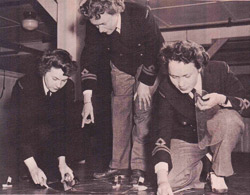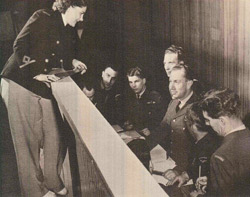Here is Carol Duffus speaking about her experiences in the Royal Canadian Navy in World War II. You can also visit The Memory Project for more stories.
Audio Transcript
My name is Carol Duffus, formerly Hendrie. I was born in Toronto, September 25th, 1918. I did finally get called up in March of 1943. So, I stayed in until September 1945. Then I served as a WREN. We were called WRENS. The British women in the navy were called WRENS too and we took that name on only we called ourselves WRENs with a C, WRCNS, Women’s Royal Canadian Naval Service. And we were associated with the navy. In Britain, it wasn’t so, they were a separate unit.
And then after a while, I, I, a position came free in the training office, a staff officer training was leaving, and so I took over at the staff officer training. And turned into the person who arranged training for the crews of any of the ships that came in, escort ships, when they needed training and tactical work or action stations or signaling or gunnery. I assigned the training in that job to, to anyone who needed it. So that was kind of interesting too. It was a good job.
The tactical table was to teach the tactics to the escort vessels when they were taking a convoy across the Atlantic. And it was six of the WREN officers took over a on a, well the tactical table wasn’t really a table, it was more like a, sort of a gym floor. Only, it had a wall all the way around it, about a little bit above a waist level.
And the WRENS, who were taking over, whenever the escorts went out, there were six taking a convoy across. So we had representatives from six escort vessels there on, on the other side of a wall, they couldn’t see us, but we could look over at them. So each of us was assigned a ship. And each ship in this escort group would send their captain and their navigating officer and the signals man up. And they would sit on the other side of the wall, they couldn’t see what we were doing up on the table. And each of us was assigned a ship so they would give us the instructions that that ship would take, in so many periods of time. It was a tactical game that was, given to the escorts, in this case, a game, a tactical game where they were taking a convoy across. There would be one at the head of the convoy and one at the stern. And then there would be one stationed on each quarter of the convoy. And they were to protect the convoy from submarine attacks.

Tactical Table Operations Photograph, 1944. Duffus at Right.
So it was a game played, it was sort of set and they would give them situations and it was all plotted out on the table by, by the WRENS who were doing the plotting on the table. It was all marked off in sections and we would chalk everything down as they’d tell us. Each of us would have one ship. They would instruct us what that ship was to do and we would plot it on the table, which was really the floor. We were down on our hands and knees for that.
And so they would play the game as situations arose, in this imaginary game that would happen. Perhaps it would be announced that there was a submarine sighted somewhere or someone had seen a, a ship blow up, so they knew a submarine had done that. These were all just cases that might happen, that was the game.
So we were, we were given these little chits every two minutes or so from our ship, each one of us had their ship and we would plot it on this tactical table. And this would go on for perhaps an hour, maybe two, as the situation arose and the uh, training commander would be there giving the instructions.

Tactical Table Operations Photograph, 1944
So at the end of the game, all the people who were doing the plotting, the captains and so on, came up on the table and they would see what they had done. And the training commander, who would review the whole situation, would see what had been done over the whole period of time by us plotting their instructions to us, as they would say, I’m going, you know, a certain degree for so, for so long and we would plot that.
So it was all laid down in chalk and when the game was over, everybody would come up on the table and then the whole thing would be criticized by the training commander. He would say to each of them, now, in this case, perhaps it would have been better if you had done this or that and so on. So it was very, it was a good educational tool and tactics, and they learned a lot that way I think.
And you often hear about women looking, being looked down on because they were women, doing a certain job. But I never, never, never felt that, ever. I was treated with tremendous respect and, and knowledge of what I was doing. And so you know, I, I think that was probably why I advanced to the staff officer training because I was respected and that I knew what I was doing and why I was there. So it was, it was fine. I had no problem at all being a woman.
An awful lot of people don’t know what the women did in the services during the war. And I think they should have a little more publicity because if it weren’t for what they did, a lot of things would not have been done. So I felt that I was able to do something useful. That was good and I think there are an awful lot of other women too who did useful things and they would never probably be recognized for what they did. I’d like to have people know that they did serve, they were very important.
[end of tape]